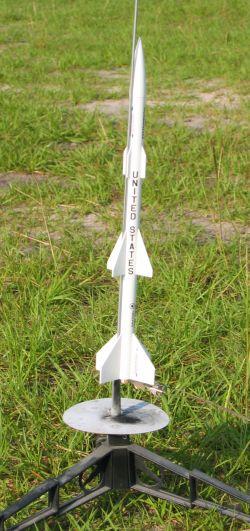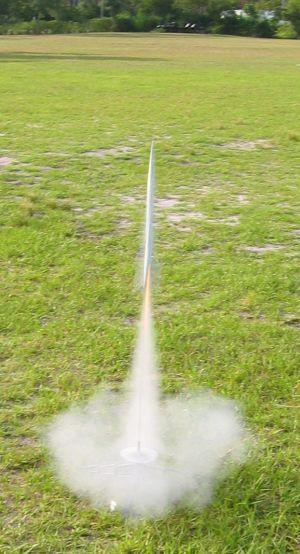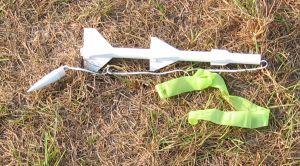Thrustline Aerospace Mini Mike IX
Thrustline Aerospace - Mini Mike IX {Kit}
Contributed by Lance Alligood
| Construction Rating: | starstarstarstarstar |
| Flight Rating: | starstarstarstarstar |
| Overall Rating: | starstarstarstarstar |
| Manufacturer: | Thrustline Aerospace |

Brief:
The Mini Mike IX is a downscale of the Thrustline Aerospace Mike IX. Aside from
being proportionately smaller, the most significant difference between the mini
version and the original is that the mini version flies on a single 13mm motor.
Construction:
The box arrived at my door 2 days after it had been shipped. I like that
Thrustline emailed me the USPS shipping confirmation to let me know that the
kit had been shipped. The box had apparently taken a bit of a rough trip by the
time it arrived on my doorstep, but the kit was very safely packaged and
sustained no damage inside the box. Being a beta version of the kit, it was
packaged inside of a large plastic bag that had been stapled. Upon opening the
bag, here's what came out:
- 1 balsa nose cone
- 1 BT-20 body tube
- 1 BT-5 motor tube
- 1 motor block for BT-5
- 2 CR520-P paper centering rings
- 1 laser cut balsa fin set
- 2 launch lugs
- 1 streamer kit
- 1 elastic shock cord
- 1 tri-fold paper mount
- 1 TADS-BT20 waterslide decal sheet
- 1 wraparound fin marking guide
- 1 instruction manual
What first caught my eye was the instructions. They were printed on several 8.5x11" pages and contained plenty of color pictures and diagrams for each step. Reading through the instructions, I didn't see any potential "gotchas" nor any errors. I used Elmer's ProBond wood glue for the entire build.
Like any good LPR build, it all starts with the motor mount. The BT-5 tube gets a small paper motor block glued in one end followed by a centering ring flush with the same end and then another centering ring 1/4" from the other (aft) end. The entire assembly is glued flush into one end of the BT-20 body tube.
After the mount has had a chance to dry, I cut out the wraparound fin marking guide. Unfortunately I was unable to use it because it fit BT-50, not BT-20. I put it aside, pulled out my Estes Fin Marking guide, and marched on through the rest of the build. I marked 4 lines 90 degrees apart running the full length of the tube. Marks are then made for the placement of the mid and forward canard fins.
The fins are 1/16" thick balsa but were impressively tough when cut out of the sheet. I was frankly thrilled to have all 12 fins laser cut! The fins were placed very close together on the sheet. It would have taken forever to cut those out by hand, not to mention that I certainly would have needed a lot more balsa to cut them out! I cut the fins from the sheet with a X-Acto knife and new blade. Only minor sanding was required to get the fins matched and smooth. I chose to not bevel the (tiny!) edges of the fins.
I used the "double glue" method to apply all fins. I started by applying the main aft fins first and worked my way forward, making sure to carefully align the fins. Small fillets were applied once the fins were dry.
Next the tri-fold mount was cut out and glued to one end of the elastic shock cord. The elastic was about 24" long and I think that should be more than adequate for this small of a kit. That mount was glued in an inch or so from the forward end of the rocket. I twisted the screw eye into the base of the nose cone, removed the screw eye, put glue on the threads of the screw eye, and twisted the screw eye back into the nose cone. The other end of the shock cord was tied onto the screw eye.
The last things were gluing the launch lugs on and attaching the streamer. They are glued into the joint of the aft and middle fins against the body tube. The streamer came in its own plastic baggie and contained a piece of neon green plastic, Kevlar® string, and a snap swivel. The instruction manual says to build the streamer according to the instructions included with the streamer. My streamer did not come with anything other than the 3 parts. There was a picture in the kit's instruction manual that had a picture of the completed streamer so that was more than adequate for me to build the streamer.

Finishing:
Thanks to the impressive decal sheet that was included with the kit, I chose to
paint the rocket all white so that it would show off the decals best. First
though, I used some diluted Elmer's Fill 'n' Finish to seal the fins and nose
cone. I sanded them smooth with 320 grit and then 400 grit sandpaper. The
rocket was coated with Krylon white primer and sanded with 400 grit sandpaper
again. Lastly, a coat of gloss white finished the rocket. I applied a few of
the waterslide decals to give it a real military missile look.
Construction Rating: 5 out of 5
Flight:
Any 13mm motor with an ejection charge are recommended for the Mini-Mike IX.
A10-3Ts were the easiest acceptable 13mm motor I could get my hands on so
that's what I used for both flights. A 4 or 5 sheets of Estes wadding were
placed inside the rocket followed by the streamer and shock cord. The body tube
was too small for me to push the wadding down far enough with my finger to have
room for the streamer so I employed the service of a small wood dowel. The
motor is retained by friction fit.
The Mini Mike IX wasted no time in getting off the pad but was easy to track throughout the entire flight. Apogee was at what I guess to be nearly 400 feet and the nose cone was definitely still pointed up in both flights.
Recovery:
The plastic streamer took a little heat on the first flight and burned
slightly, however it still recovered safely and within 10 yards of the pad. A
small piece of clear tape over the damage along with an extra piece of wadding
had the Mini Mike IX ready for flight #2. There was no damage on the second
flight, otherwise it was an exact repeat of the first flight.

Flight Rating: 5 out of 5
Summary:
With its military-esque looks and great flights, the Mini Mike IX would be a
welcome addition to any low power flier's fleet. It's a great choice for those
days when you really want to launch a rocket but perhaps don't have the time or
large field for an organized launch although I'm sure it'll get plenty of
attention then too!
Overall Rating: 5 out of 5
Sponsored Ads
 |
 |











